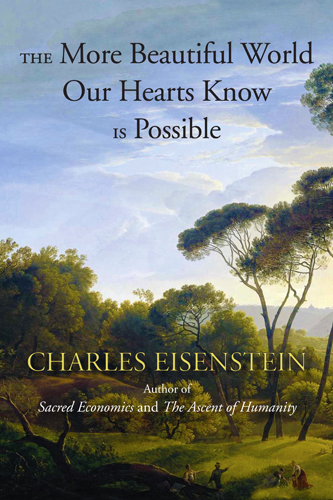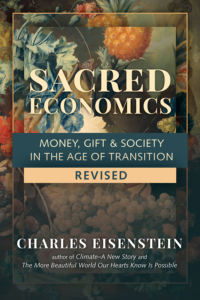Climate — A New Story
Chapters
Chapter 11: An Affair of the Heart
The Powers of the Land
The problem with the mechanistic view of nature-as-thing is not only that it numbs our compassion and facilitates our plunder. It also cripples our ability to serve as agents of positive transformation. One reason is that from the mechanistic perspective we cannot fully understand the needs of land, ocean, soil, water, or forest, just as I could not fully serve my son’s needs if I saw him as a biomechanical robot merely requiring precise inputs of various substances.
Another reason is that it leaves us without allies. If the world outside ourselves lacks purpose, intelligence, and agency, then change is entirely up to ourselves, dependent on how much force we can exert on matter.
Without allies in the cause of ecological healing, the situation is grim. As I asked before, can we beat the military-industrial-financial-agricultural-pharmaceutical-NGO-educational-political complex at its own game—the game of one force against another? If we have no allies, if humans are the sole possessors of intention in a random world, then we are lost.
What becomes possible when we believe we have companions inconceivably more powerful than ourselves with whom we can align? What becomes possible when we seek to participate in a larger ordering intelligence?
Older cultures commonly believed that mountains, rivers, animal species, the ancestors, and other seen and unseen beings participated in human affairs and could alter the course of history. Can we access these beings as allies too?
A word of caution here: this is not the kind of alliance that we are accustomed to in war thinking. We are not enlisting an even bigger force in a contest of force versus force. In fact, the allies abandon us when we inhabit that mentality, which is kindred to the story of nature-as-thing. That mentality casts us into a universe in which the allies do not exist. They become invisible to us through the lens of instrumental utilitarianism, through the lens of “resources,” minerals, commodities, and profit. One might ask, “If the powers of nature are so great, then why haven’t they put an end to the destruction?” If there is, as indigenous people tell us, a power in the land, in the mountains, in the forest, in the waters, that is greater than human power, why are all of these dying at human hands? It is because theirs is not a power of force versus force.
Stephen Jenkinson puts this poignantly in his magnificent book Come of Age:
The wild doesn’t play by the rules as we know them. But the wild is governed by a kind of ruthless etiquette; it does not preserve itself by subverting its wild soul. Who among us has not been on some camping trip or the like and seen the inexorable creep of civilization coming on, the intrusion of distant neon on what was once a dark night? How many times have you heard older people remember a time, not so long gone, when every developed part of your life was a field of Queen Anne’s lace and deer spoor? How many of you have harbored a wish that something of the wild would rise up and smite Big Pharma, or Big Agra, or the Military Industrial Complex, or your local bad guy equivalents, Armageddon-movie style, just enough to reinstate the boundary line and lend us a little hope, and then forgive the rest of us enough to allow a little conscious ecotourism to help with the maintenance costs? The wild seems terribly vulnerable in our time. To respond in kind to the indignities and rapacious practices we oblige it to endure would be to practice our kind of “desolation by payback,” our kind of retributory justice—the very undoing of the wild’s other-than-human ways of being itself. So this defenselessness sustains the wild’s soul, you could say. It is heartbreaking. And if the wild expires at our hands in decades to come, species by species, place by place, it does so as the wild does, not in soullessness, not in punition, but in silence.[6]
Yet this does not mean we cannot come into relationship with these beyond-human powers. We cannot impose our terms upon them or pervert them to our ends, but we might align ourselves with the tiny sliver of theirs with which we intersect.
The Australian activist Daniel Schneider told me a story about a protest against a fracking project in New South Wales. Thousands of people, including many aborigines, occupied the site, set up a camp for three months, blockaded the roads, chained themselves to cars, and sat on top of poles to block heavy equipment from entering. “Basically, we were preparing for battle,” Dan said. They found out that a force of eight hundred police was being prepared to move in the next week, along with agents provocateurs to create a pretext for mass arrests. The protesters prepared for a showdown—not to actually fight the police of course, but to battle for public attention and media exposure. They had drones and cellphone cameras sending live feeds to global activists. They were prepared to win the war of public perception and expose the villainy of the police and the government.
As tensions were reaching their peak, Dan proposed an idea to a group of aborigines at the site. Everyone felt the foreboding that they were entering a losing battle, so why not try something else? Since they knew media helicopters were coming, why not make giant art installations visible from the air for them to film, instead of the usual script of police arresting activist hippies? The aborigines loved the idea, brought out their dreaming stories, and soon had sketched designs for two-hundred-foot giant rainbow serpents and other figures to be drawn on the ground with sacred ochre. They also planned to greet the police ceremonially, with giant fires making sacred eucalyptus smoke, and five hundred men painted in ceremonial colors with clapping sticks and didgeridoos.
The next morning Dan got a phone call. The government had canceled the fracking license.
Later an indigenous elder woman came to him. “Thank goodness we let go of conflict. That is why we were successful. I’ve seen it before,” she said. “Usually it is the same story. The police come in, all the blackfellas get arrested, lots of the whitefellas get arrested, and the project continues. But this time, because we let go of conflict and entered into art and ceremony, the ancestors of the land could come in and exercise their power.”
I heard a different version of this story from my dear friend Helena Norberg-Hodge, who lived an hour from the site. According to her, the victory came thanks to the “knitting ladies”—older women, white and aboriginal, who, as they quietly went about their knitting, kept peace in the encampment, restrained the fighting and drunkenness that broke out among the men, and opened up backdoor communications channels with the police. Working behind the scenes, they shifted the dynamic away from confrontation; furthermore, by humanizing the protesters they disabled the narrative of “environmental extremists” that would have facilitated a police invasion.
I see these two versions of the story as complementary, not contradictory. How do the “ancestors of the land” exercise their power, if not through the quiet faith of the knitting ladies? What power sustains those women? What holds them in peacefulness against the onslaught of us-versus-them thinking?
In the story of force versus force, the deeper sponsoring assumption is that if anything purposeful is to happen, we have to make it happen. It has no room for the agency of other beings to engineer synchronicity. It locks us in a world where the ancestors and the powers of the land have no room to operate. Nor does it allow the women to wield their feminine power to hold the peace so that the ancestors and the land can do their work. In fact, it says to them—women, ancestors, and earth powers—“We don’t need you. We don’t acknowledge you.”
This mentality is akin to the geomechanical view of climate change, which also discounts the ability of living systems to maintain conditions for life. They can—if only we let them. But we do not let them; instead we actively degrade and destroy that capacity. We kill forests, lakes, mountains, and swamps in part because we see them already as dead, using the same vision that excludes the powers of the land from operating in ways that are more mysterious than regulating the carbon cycle, the water cycle, and the surface albedo.
By the same token, we must let all these beings “maintain conditions for life” by aiding us in the realms of technology and politics. When we engage in confrontational tactics or fight the destroyers in court, we must remember that it is not all up to us. We must remember that purposive change is possible beyond what we direct ourselves. We must remember that this is not a fight we can win just by fighting.
Have you ever noticed in life that the most striking synchronicities seem to happen in times of uncertainty? When one moves to a new city without a plan, or travels without an itinerary, or does something out of the ordinary with no idea of what will happen, then quite often an amazing (sometimes life-changing) meeting or stroke of luck or “chance” encounter occurs. They rarely happen when everything is planned, predictable, and controlled. It is as if the spirits have no room to come in.
To enter the realm of synchronicity, the aid of the ancestors, and alliance with the powers of the land is not the same as sitting around doing nothing and wishing it will happen. It is not enough to “send positive energy.” A sacrifice of some sort is required, something that involves risk or loss. It might be the sacrifice of time, energy, and money. It could be a sacrifice of certainty or control, an act that feels like a step into the true unknown. It could be a demonstration of commitment that feels real to you. It might be the sacrifice of “winning”—of having the satisfaction of seeing your opponent admit he was wrong. It might be to sacrifice setting up the situation so that you get to be the leader or get credit for the success. It might be the sacrifice of a polarized, dehumanizing view of the other side that makes you out to be the good guy. It might be the sacrifice of a self-image; for instance, being the one with the answers.
Another way to understand the necessity of a sacrifice is that who I am right now is not in full alignment with the more beautiful world I wish to help create. In order to be its effective servant, and in order to inhabit the reality in which it is possible, I must undergo a transformation. Something will be lost and something will be gained. I must give something up to align with the future that calls to me.
The sacrifice I speak of is usually not deliberate, but the result of a realignment of the self to a different life purpose or creative goal. What is deliberate is to commit life energy in service of the prayer, to take action in the 3D world. Conventional actions, especially those demanding hard work, significant money, or risk of imprisonment, constitute a commitment ritual that communicates to the unconscious and to all who are watching, “I am serious about this.”
That which hears our prayers gets fed up with prayers that aren’t serious. Often in our culture, we wish for things to be one way but act in direct contradiction to that wish. So the Listener wonders, “Do you really mean it? Let me make sure.” The Listener then creates a situation—a challenge or a setback—that gives the wisher a chance to clarify whether she really means it.
The environmentalist Mark Dubois told me a story about a campaign he and other environmentalists waged in the 1970s and early ’80s to stop the New Melones Dam from being built on a pristine stretch of the Stanislaus River. Their group of activists tried everything from legal challenges to petitions to lobbying for legislation to physical direct action (Mark chained himself to a boulder to prevent the authorities from filling the reservoir), all to no avail. They poured so much of their hearts and souls into the campaign that when they finally lost, their pain and grief were so great that many could not bear to visit the flooded canyon. It felt like a total defeat. Yet, the New Melones project marked a turning point. It was the last dam of its size built in the United States; since then, every new dam project has met with stiff opposition, and more dams have been removed than have been constructed.
Certainly, one could cite mundane explanations for the end of the dam-building era. Few viable sites remain in North America; the visibility and cost of the New Melones fight made the authorities lose their appetite for further projects; the resistance heightened public awareness of the damage dams cause. All true, yet on another level we might understand the failed campaign as a kind of prayer. When we put everything we’ve got into the service of a vision, the world takes notice and reality shifts. Our failures are our prayers. This is not to suggest we commit to an impossible cause, hoping that performing the rituals of protest will magically bring the impossible result we wish for. It means doing the best we can based on the knowledge we have, knowing that our sincere commitment will impact the world. No sincere action is ever in vain.
We cannot be sure our prayers will be answered in the form we expect. We can be confident though that our prayers are at least heard. We are not alone here. Something is watching. Something is listening.
I can imagine my evangelical Christian friends saying, “Yes, that ‘something’ you are talking about is God.” I agree with them, except that they conceive God as an immaterial being, a spirit that directs matter but is separate from it. Holding matter itself as insensate, they agree with scientific reductionism. I would say that the “something” that is listening is everything: earth, sky, water, air, rocks, trees, animals, plants … along with beings we do not see and that have no name (in English, anyway). Matter is sentient, watching, listening; God, you might say, is in all things, and nothing is not God.
End Notes
[6] Jenkinson (2018). From a prepublication draft sent to me by the author.






